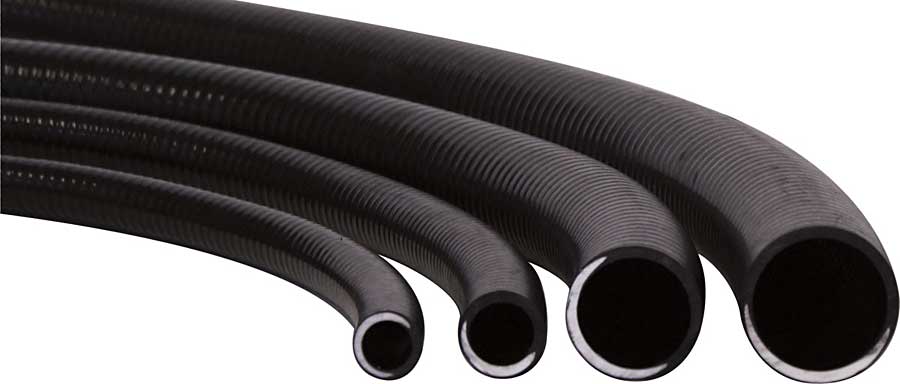Pond owners often put a lot of thought into the pump they choose, but usually very little into which size tubing to use. Pond tubing is an often overlooked piece of pond equipment, but if you choose tubing that it too small, it will significantly decrease the flow of your pump.
A pump must have the power to not only push water vertically up to the top of your waterfall or filter, but also overcome the friction created inside the tubing or pipe. Pumping 2000 GPH of water through a 1 1/2″ tubing creates very little friction inside the pipe. However, if you pump the same 2000 GPH through 1″ pipe, the water will travel much faster through the pipe and create more friction. More friction creates more pressure on the pump and reduces the flow.
Choosing the correct diameter of kink free or PVC tubing is crucial to get the maximum flow from your pump.

Although it may not seem like there is a big difference in size between ¾” and 1” tubing, the 1” tubing has 80% more surface area (the space inside the pipe) than the ¾”. That is a huge difference! You can pass 80% more water through the 1″ tubing without increasing the friction created in the pipe.
The chart below shows the surface area inside of various sizes of pond tubing. What does this mean? Basically, when you compare 1 ½” and 2″ tubing, you have to run 2 separate lines of 1 ½” tubing to provide as much surface area of the 2” tubing.
| Tubing Diameter | Surface Area (square inches) |
|---|---|
| 3/4" | 0.44 |
| 1" | 0.79 |
| 1 1/4" | 1.23 |
| 1 1/2" | 1.77 |
| 2" | 3.14 |
| 3" | 7.07 |
| 4" | 12.57 |
| 6" | 28.27 |
| 8" | 50.26 |
The faster water is forced through a pipe, the more turbulence and friction is produced. This friction creates more pressure on the pump and results in lower flow. This is referred to as Friction Loss. Attaching a small diameter tubing to a large pump drastically increases the friction and restricts the flow. In addition, the longer the length of pipe used, the more pronounced the effect is.
Let’s say you you bought a pump that has a flow of 3600 gallons per hour (GPH). You have a long stream connecting your waterfall to your pond, so you need 50’ of tubing. The pump comes standard with a 1 ½” tubing adapter, but is that really the best tubing to choose? Look at the chart below to compare the friction loss in different diameters of pipe.
| GPH | 1" | 1 1/4" | 1 1/2" | 2" | 3" |
|---|---|---|---|---|---|
| 1200 | 21.75 ' | 5.59' | 2.61' | .76' | .11' |
| 1800 | 11.85' | 5.53' | 1.62' | .23' | |
| 2400 | 20.18' | 9.43' | 2.75' | .4' | |
| 3000 | 10.51' | 4.25' | .66' | ||
| 3600 | 19.98' | 5.84' | 1.13' | ||
| 4200 | 7.76' | 1.13' | |||
| 4800 | 9.94' | 1.44' | |||
| 5400 | 12.37' | 1.8' | |||
| 6000 | 15.03' | 2.18' | |||
| 7500 | 3.31' | ||||
| 9000 | 4.63' | ||||
| 10,500 | 6.16' |
Here is an example showing the actual effect of tubing size on a pump.
Let’s say you purchased a Tsurumi 3PL pump. This pump has a maximum output of 3300 GPH. As mentioned in the example above, if you run 50’ of 1 ½” tubing to waterfall, there will be around 10’ of friction loss in the pipe (equivalent to 10’ of head pressure).
From the Pump Flow Chart below, at 10’ of head, the Model 3PL’s output will be reduced to 1700 GPH. But if you use 2” pipe, the friction loss is equivalent to 3′ of head and the pump output will be around 3000 GPH

The chart below shows the ideal as well as the maximum recommended flow rates for various tubing sizes. To get the best performance and the most volume of water from your pump choose the ‘Ideal Flow Rate’ column, especially if you are pumping through long runs of pipe (40 feet or more).
Assuming your pump output is 3300 GPH and you only need to use 10’ of tubing.
Although the 3000 GPH in the chart is less than the 3300 GPH of your pump, there will be little reduction in flow if you are using only 10’of tubing. If you needed to use longer runs of tubing, like 50″ in the example above, it is definitely worth while to go to the next larger size of tubing (2″) to get the best performance from your pump.
| Diameter | Ideal Flow Rate | Maximum Flow rate |
|---|---|---|
| 1/2" | 300 GPH | 420 GPH |
| 3/4" | 600 GPH | 900 GPH |
| 1" | 1200 GPH | 1500 GPH |
| 1 1/4" | 2100 GPH | 2700 GPH |
| 1 1/2" | 3000 GPH | 3600 GPH |
| 2" | 4800 GPH | 5400 GPH |
| 3" | 12,000 GPH | 15,000 GPH |
| 4" | 21,000 GPH | 24,000 GPH |
| 6" | 36,000 GPH | 42,000 GPH |